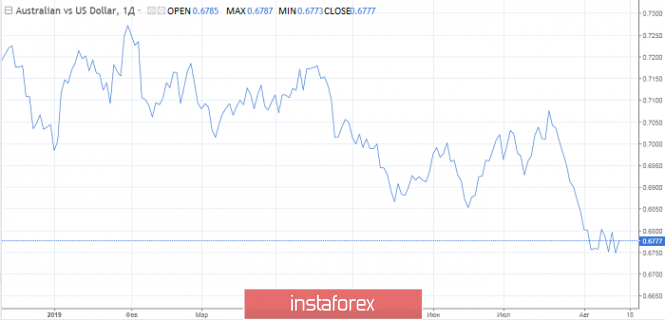
Several central banks in the Asia-Pacific region have sharply reduced their interest rates. Many regulators are ready to follow their example, since mitigation in the US and Europe provides them with a certain freedom of action. It is worth noting that the Asia-Pacific regulators not only responded to changes in the policies of the ECB and the Fed, but also try to anticipate their next steps. They expect the ECB to implement the planned measures, and possibly reduce the rate by the Federal Reserve at the September meeting.
The Bank of New Zealand cut the rate from 1.5% to 1%, although the markets did not expect such a generous surprise. We can say that in this way the regulator paved the way for a similar easing of monetary policy in Australia.
In this regard, the AUD/USD pair is prone to further decline from a fundamental point of view, despite the fact that its recovery is observed on Thursday. The growth was facilitated by positive data on the country's labor market. On Wednesday, data were published indicating an increase in wages in Australia. However, this is not enough to accelerate inflation. The moderate wage growth, coupled with the current unemployment rate, suggests that the RBA will lower the rate again by the end of this year.
"It is reasonable to expect that a long period of low interest rates will be required for progress towards reducing unemployment and confidently moving towards the target inflation rate," said the head of the Australian central bank following a meeting in early August.
The expectation of a softening of the RBA's policy makes the aussie vulnerable.

Growing signs of global recession
The heads of the world central banks are making efforts to stimulate the economy in connection with the growing risks of a global recession. Compounding negative expectations, the US-China trade conflict is becoming increasingly violent.
However, it is far from the fact that cheap money will help to change the situation for the better, but the central bank is not backing down. High rates support exchange rates, while the United States, Europe and China are struggling to keep their national currencies in check.
The central bnk of Switzerland and England, which are issuers of two reserve currencies, also came under general influence. For example, for Switzerland, which recently initiated interventions to weaken the franc, this would mean further immersion in the negative zone.
The Bank of England not so long ago spoke of its intention to tighten its monetary policy. Unlike other industrialized countries, Britain is facing inflationary pressures, but the growing uncertainty about Brexit is forcing the central bank to follow the worn-out path - lowering rates to mitigate the effects of an erratic exit from the European Union.
The US market fell amid another inversion of the yield curve. In the UK, the yield on 2-year government bonds increased by one basis point, and on 10-year bonds, it decreased by 2 basis points, also reversing this curve. Inversion does not always and not immediately acts as a guarantee of an immediate recession. However, given extremely pessimistic data (such as a decline in German GDP), markets may succumb to real panic.
The material has been provided by InstaForex Company - www.instaforex.com